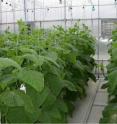Twin-head cucumber system reduces start-up costs
Greenhouse vegetable production in North America has more than doubled in the past 10 years. While heavy investments have been made in modern greenhouses, improved cultivation technologies are essential for producers to realize the high productivity potential afforded by the improved facilities. Gaining popularity in greenhouse vegetable production is a high-wire system in which cucumbers plants are trained into a single stem. The system allows for uniform foliar and light distribution and higher yield and quality, but requires much higher plant densities than the conventional "umbrella" system, often resulting in increased crop start-up costs. To help address these critical financial issues, researchers developed a new twin-head ''V'' high-wire cucumber system and compared it to the conventional single-head system. A report in HortTechnology detailed the performance of the twin-head system.
The researchers raised twin-head transplants by topping the seedlings after the appearance of the fourth true leaf; two strong lateral shoots were then allowed to develop and were trained into a ''V'' system after planting. Results of the 2-year experiments proved that the twin-head system achieved similar plant growth and fruit yield as the conventional single-head system on two long English seedless cucumber cultivars (Bodega and Myrthos) and two breeding lines. "While there was little difference in plant growth between the two systems, the twin-head system had a higher percentage of medium fruit and a lower percentage of small fruit than did the single-head system with cultivar 'Bodega' ", the scientists noted.
The twin-head system significantly reduced production costs. "The material and transportation costs for single-head and twin-head transplants were the same, but since the twin-head system used only half the number of transplants of the conventional single-head system, its transplant cost was reduced by almost half", explained the study's corresponding author Xiuming Hao.
"The twin-head ''V'' high-wire cucumber system achieved the same fruit yield as the conventional single-head system and also achieved better fruit grades in some cultivars while it significantly reduced transplant costs", concluded Hao. "In this research we have shown that the twin-head ''V'' high-wire cucumber system is a more cost-effective system than the conventional single head high-wire system."
Source: American Society for Horticultural Science
Other sources
- Twin-head cucumber system reduces start-up costsfrom Science DailyMon, 27 Jun 2011, 16:30:44 UTC
- Twin-head cucumber system reduces start-up costsfrom PhysorgMon, 27 Jun 2011, 14:31:11 UTC
